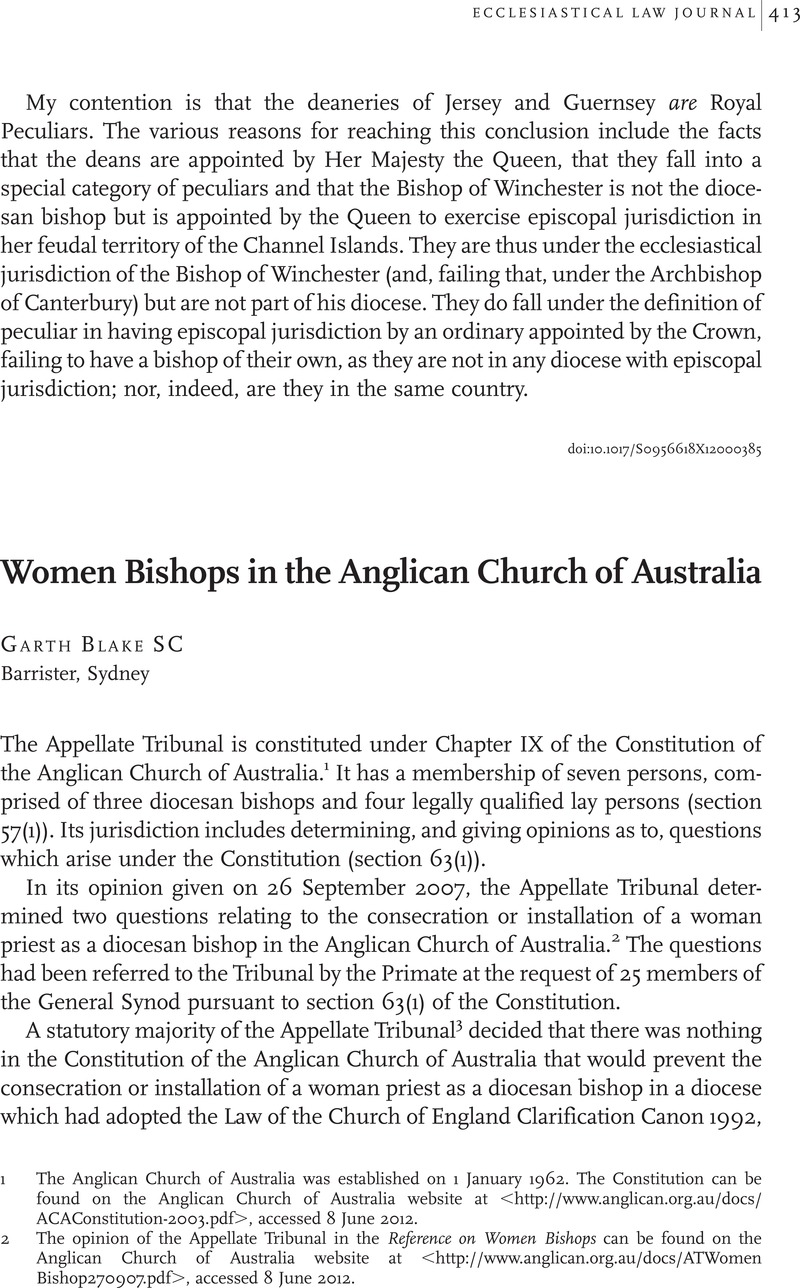No CrossRef data available.
Article contents
Women Bishops in the Anglican Church of Australia
Published online by Cambridge University Press: 22 August 2012
Abstract

- Type
- Comment
- Information
- Copyright
- Copyright © Ecclesiastical Law Society 2012
References
1 The Anglican Church of Australia was established on 1 January 1962. The Constitution can be found on the Anglican Church of Australia website at <http://www.anglican.org.au/docs/ACAConstitution-2003.pdf>, accessed 8 June 2012.
2 The opinion of the Appellate Tribunal in the Reference on Women Bishops can be found on the Anglican Church of Australia website at <http://www.anglican.org.au/docs/ATWomenBishop270907.pdf>, accessed 8 June 2012.
3 Section 59(1) of the Constitution provides that in all references to the Appellate Tribunal in any matter involving any question of faith, ritual, ceremonial or discipline the concurrence of at least two bishops and two laymen shall be necessary for the giving of an opinion upon a reference.
4 Report and Opinion of the Tribunal on the Eleven Questions Appertaining to the Ordination of a Woman to the Order of Priests or the Consecration of a Woman to the Order of Bishops.
5 This Canon has no operation in a diocese unless it is adopted by ordinance by the synod of the diocese. Not all dioceses of the Anglican Church of Australia have adopted it.
6 Justice Mason was then the President of the Court of Appeal Supreme Court of New South Wales. The other members were Justice David Bleby, who was then a judge of the Supreme Court of South Australia, the Most Reverend Dr Phillip Aspinall, the Primate and Archbishop of Brisbane, and the Most Reverend Roger Herft, the Archbishop of Perth.
7 Justice Mason referred, inter alia, to Burn, R, Ecclesiastical Law (eighth edition, London, 1824), p 194Google Scholar; Phillimore, W, Ecclesiastical Law of the Church of England (second edition, London, 1895), pp 22, 33–34, 38–42, 93Google Scholar; Cripps, H, A Practical Treatise on the Laws Relating to the Church and the Clergy (eighth edition, London, 1937), pp 25–26, 74–75Google Scholar; Halsbury's Laws of England, vol 13 (third edition, London, 1955), pp 8–9, 156–159, 161, 163, 198Google Scholar; R v Archbishop of Canterbury (1848) 11 QB 483; 116 ER 557 (Bishop Hampden's case); R v The Archbishop of Canterbury [1902] 2 KB 503 at 541 per Lord Alverstone CJ; Paregon Juris Canonici Anglicani, John Ayliffe, 1726, 119.
8 Justice Mason referred, inter alia, to Ex parte The Rev George King (1861) 2 Legge 1307; Long v Bishop of Cape Town (1863) 1 Moore NS 411, 15 ER 756; Bishop of Natal v Gladstone (1866) LR 3 Eq 1.
9 That is, that women and unbaptised persons may not be ordained.
10 Justice Young referred, inter alia, to R v Archbishop of Canterbury (1848) 11 QB 483; 116 ER 557 (Bishop Hampden's case); R v Archbishop of Canterbury [1902] 2 KB 503; Paregon Juris Canonici Anglicani, John Ayliffe, 1726, 119; Grey, R, A System of English Ecclesiastical Law (second edition, London, 1732), pp 30ffGoogle Scholar; Wharton, H, Anglia Sacra (London, 1691), pp 735–736Google Scholar.


